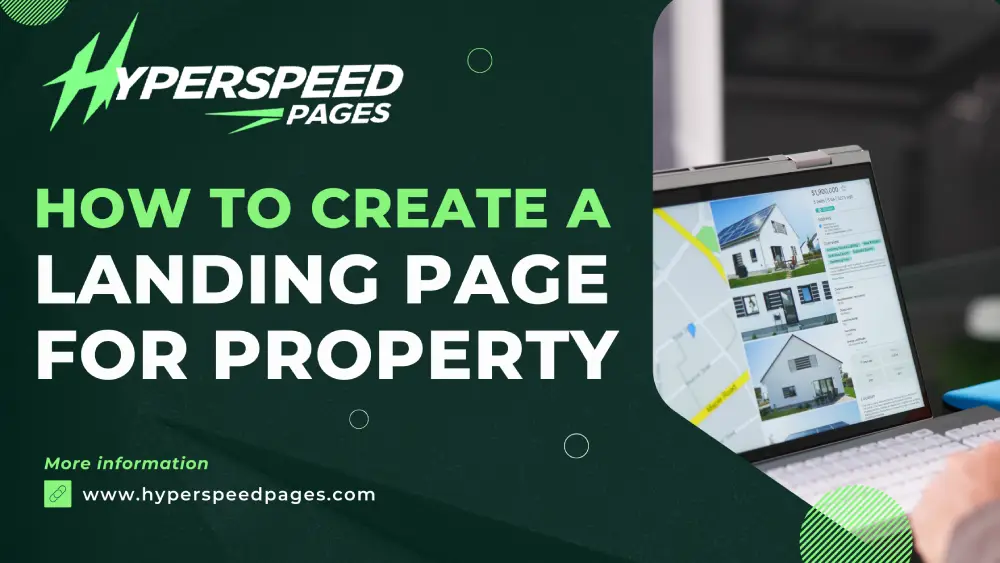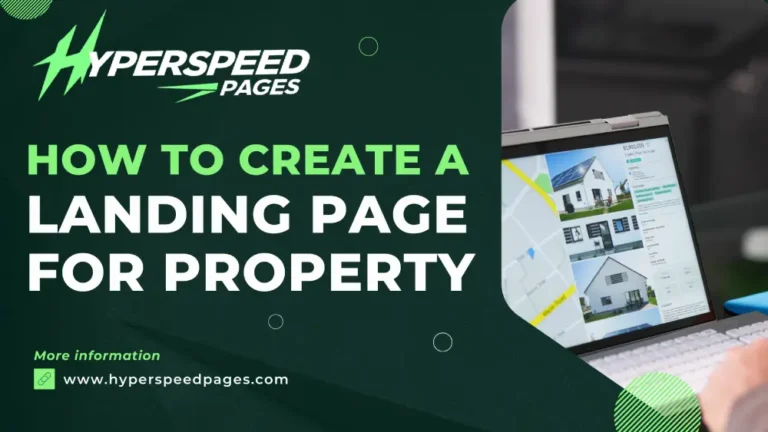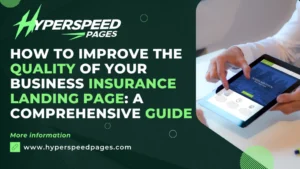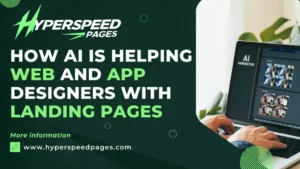
A successful landing page showcases property listings; builds trust, offers value, and directs potential clients down the conversion path. But knowing what to include and what to avoid can make all the difference in a competitive market.
We’ll cover the essential elements to include on a property landing page and common pitfalls to avoid. This will help you maximize your landing page’s impact for optimal engagement and search visibility.
Purpose of a Real Estate Landing Page
A property landing page serves a single goal: converting visitors into leads or clients. Unlike a standard webpage, which may have multiple functions and navigation points, a landing page is streamlined for one primary call-to-action (CTA).
The purpose of a real estate landing page can vary, but common objectives include:
- Capturing leads for a specific property or neighborhood.
- Showcasing a real estate agent’s portfolio.
- Offering free resources like guides or property valuations.
- Promoting special offers, such as exclusive access to new listings.
- Essential Elements to Include in a Real Estate Landing Page
Introduce a Headline
A well-crafted headline is one of the first things visitors notice, so make it clear and concise. It should:
- Highlight the primary benefit to the visitor (e.g., “Discover Your Dream Home in Downtown New York”).
- Be visually prominent, using a font and color that stand out.
- Reflect what visitors will gain by exploring further.
Appealing Visuals
Aesthetic appeal is crucial in real estate. Potential buyers or renters want to envision themselves in a property, and images and videos can provide this experience better than text alone. When adding visuals:
- Include high-resolution photos of key property features: interior shots, views, and amenities.
- Add a virtual tour or video walkthrough for an immersive experience.
- Ensure all visuals are optimized for quick loading without sacrificing quality, as slow-loading pages can increase bounce rates.
Capture Hearts with Call-to-Action (CTA)
The CTA guides visitors toward your page’s goal, whether it’s filling out a form, contacting you, or scheduling a viewing. A successful CTA is:
- Highly visible and action-oriented (e.g., “Schedule a Viewing Today!” or “Get Your Free Property Valuation”).
- Placed above the fold so users can easily find it without scrolling.
- Reinforced with urgency where appropriate (e.g., “Limited Availability!”).
Detailed Property or Service Description
In real estate, clarity and detail matter. The description section should:
- Highlight key property features (e.g., number of bedrooms, square footage, location highlights).
- Address pain points or desires of your target audience (e.g., family-friendly neighborhoods, proximity to schools).
- Avoid jargon and use conversational language that’s easy to understand.
Social Proof and Testimonials
Building trust is essential in real estate, where decisions involve significant investments. Including social proof, such as:
- Client testimonials that highlight your reliability, professionalism, or market knowledge.
- Ratings and reviews from third-party sites like Zillow, Realtor.com, or Google.
- Case studies or success stories that demonstrate how you’ve helped clients achieve their real estate goals.
Lead Capture Form
Lead capture forms convert visitors into potential clients. Ensure your form:
- Asks only for necessary information (e.g., name, email, phone number), as lengthy forms can deter users.
- Clearly states why you’re collecting information and how it benefits the user (e.g., “Get a Personalized Property Report!”).
- Is designed with a CTA, such as “Submit” or “Get My Free Consultation”, and has simple validation to avoid user frustration.
SEO-friendly Content and Meta Tags
For your landing page to rank on Google, incorporate SEO best practices, such as:
- Primary keywords like “luxury real estate”, “homes for sale in [location]”, etc.
- Engaging meta descriptions that clearly outline the page’s purpose.
- Relevant internal and external links to boost credibility and provide value (e.g., links to neighborhood guides or mortgage calculators).
- Signup to newsletters landing page for real estate
Contact Information and Agent Details
Displaying contact information prominently enhances trust and allows clients to reach out directly. Include:
- Your phone number and email address.
- Agent profile with a photo, biography, and social media links.
- Office location if it’s relevant to your service area, which can also enhance local SEO.
Common Pitfalls to Avoid on a Real Estate Landing Page
– Overloading the Page with Too Much Information
While you want to inform potential clients, avoid overwhelming them with excessive details. Focus on the most critical features and benefits, directing visitors to contact you for additional information.
– Multiple, Competing CTAs
A successful landing page has a single CTA or, at most, two. Having multiple CTAs (e.g., “View Listings” and “Subscribe for Updates”) can confuse visitors. If you need more than one CTA, prioritize them with size and color to emphasize the primary action.
– Poor Mobile Optimization
With most people browsing on mobile devices, a landing page should be fully responsive. Ensure that:
- All visuals resize effectively.
- Forms are easy to fill out on smaller screens.
- CTAs remain prominent and clickable.
– Using Stock Images Instead of Authentic Visuals
Stock images can come across as impersonal and, in some cases, untrustworthy. Whenever possible, use authentic images of your properties, neighborhood, and even your team to build a stronger connection with visitors.
– Slow Page Load Times
Real estate landing pages are often image-heavy, and high-quality visuals can slow load times if not optimized. Compress images and use a reliable content delivery network (CDN) to ensure fast load times. A slow-loading page can increase bounce rates and negatively impact Google rankings.
– Failing to Track Performance Metrics
If you’re not tracking metrics, you’re missing out on valuable data that can help you optimize. Set up tracking for:
- Visitor count, source, and behavior with Google Analytics.
- Conversion rates to see how effective your CTA is.
- Heat maps to understand where users are spending time on your page.
– Ignoring Legal and Compliance Factors
Failing to address privacy concerns and compliance can harm trust. Include:
- A privacy policy to outline how you’ll use visitor data.
- Compliance badges or text if necessary (e.g., ADA compliance or Fair Housing regulations).
- A cookie policy if you’re tracking behavior with cookies.
The Cost Breakdown
Adding a cost breakdown for each technical aspect of a real estate landing page will help you budget effectively and understand where to allocate resources. The following costs are estimated and may vary depending on your location, the complexity of the design, and whether you work with an agency or freelance professionals. Here’s a detailed breakdown:
a) Headline and Copywriting
Cost Estimate
- Freelance Copywriter: $150 – $500
- Content Agency: $500 – $1,500
Details
The headline and supporting text are crucial for creating a strong first impression. Experienced copywriters can craft compelling, keyword-rich content that resonates with your target audience and boosts SEO. Investing in professional copy will also ensure that your page is optimized for conversions.
b) Visuals (Photos, Videos, and Virtual Tours)
Cost Estimate
- Professional Real Estate Photography: $300 – $800 per session
- Video Production: $500 – $2,000 (depending on complexity)
- Virtual Tour Creation: $300 – $1,500 per property
- Stock Photos (if necessary): $10 – $100 each, but avoid over-reliance on stock images
Details
Visuals are critical in real estate. High-quality photos, videos, and 3D virtual tours offer a realistic sense of the property and engage viewers. For listings or service-focused landing pages, budget for at least one professional photo session and, if possible, a short promotional video or virtual tour.
c) Web Design and User Experience (UX) Design
Cost Estimate
- Freelance Web Designer: $1,000 – $3,000 for a landing page
- Web Design Agency: $2,000 – $7,000
- UX Design Consultation (optional but recommended): $500 – $2,000
Details
Professional web and UX design ensure that the landing page is visually appealing, easy to navigate, and optimized for conversions. This process includes choosing the right layout, font styles, colors, and ensuring mobile responsiveness.
d) Prominent Call-to-Action (CTA) Button
Cost Estimate
- Web Designer (included in above)
- Testing Tools (e.g., A/B testing for CTA): $20 – $150 per month (for tools like Optimizely or Google Optimize)
Details
The CTA design is typically part of the overall web design, but budget for A/B testing tools to optimize your CTA performance. Testing different colors, placements, and text can increase conversion rates significantly over time.
e) Property or Service Description Content
Cost Estimate
Copywriting: $200 – $800 (depending on length and detail)
SEO Optimization: $100 – $300 (if not included with copywriting)
Details
Detailed descriptions of the property or services help with SEO and provide crucial information for potential buyers or clients. A copywriter with real estate experience can create descriptions that highlight key selling points, add value, and appeal to potential leads.
f) Social Proof and Testimonials Section
Cost Estimate
- Copywriting/Editing for Testimonials: $50 – $200
- Design Integration: $100 – $500 (if included in the web design package, it may not cost extra)
Details
Incorporating testimonials and reviews boosts credibility. You may need professional editing to reformat or clarify existing testimonials. Additionally, web designers can style this section attractively, potentially using star ratings or icons to highlight positive feedback.
g) Lead Capture Form
Cost Estimate
- Form Design and Integration: $100 – $500
- Lead Capture Software (e.g., Mailchimp, HubSpot): $0 – $150 per month, depending on provider and usage
Details
Lead capture forms are essential for collecting user information. These forms should be visually appealing, simple to complete, and integrated with your CRM or email marketing platform to automate lead nurturing. Some lead capture software includes basic analytics, which can help you improve the form’s performance.
h) SEO Optimization (Content and Meta Tags)
Cost Estimate
- SEO Copywriting: $150 – $500
- On-Page SEO Setup (e.g., meta tags, image optimization): $100 – $400
- SEO Tools (e.g., SEMrush, Moz, Ahrefs): $0 – $100 per month
Details
For your page to rank on search engines, SEO optimization is essential. An SEO specialist can optimize your keywords, meta tags, alt text for images, and internal links. Subscription tools can provide insights into performance and help with ongoing adjustments.
i) Contact Information and Agent Profile Section
Cost Estimate
- Copywriting for Profile: $50 – $150
- Web Designer for Contact Integration: $50 – $200 (if not included)
Details
This section adds a personal touch, allowing potential clients to connect with the agent directly. Many web design packages include this section, but you may want a copywriter to refine the biography text.
j) Trust Badges and Certifications
Cost Estimate
- Design and Integration: $100 – $300
- Membership Fees (e.g., National Association of Realtors): Varies by organization, typically $50 – $300 annually
Details
Trust badges enhance credibility by showing that your business complies with industry standards. Depending on your design needs, you may need to pay a small fee for badge integration, especially if it requires custom styling.
k) Performance and Speed Optimization
Cost Estimate
Image Compression and Speed Optimization Services: $50 – $300
CDN (Content Delivery Network): $0 – $200 per month (Cloudflare, AWS, etc.)
Testing Tools (e.g., PageSpeed Insights, GTMetrix): Free, though premium versions may have costs
Details
Speed optimization ensures that your landing page loads quickly, reducing bounce rates and improving SEO. Image compression tools, caching, and a CDN can reduce load times. Some services like Cloudflare offer free basic plans for small sites.
I) Mobile Optimization and Responsiveness
Cost Estimate
- Responsive Design (included in web design): Often included in base design
- Mobile Testing and Adjustments: $50 – $200, depending on extent of optimization needed
Details
Mobile responsiveness is essential as a large portion of real estate searches occur on mobile devices. This typically requires a one-time setup by your designer to ensure all elements adapt seamlessly across different devices and screen sizes.
m) Tracking and Analytics Setup
Cost Estimate
- Google Analytics Setup: $50 – $200
- Heatmap Tools (e.g., Hotjar, Crazy Egg): $0 – $100 per month
- Conversion Rate Optimization (CRO) Consultation: $300 – $1,500
Details
Set up analytics to track performance metrics, visitor behavior, and conversions. Heatmaps reveal where users are interacting most on your page, providing valuable insights for optimization. CRO consultants can help interpret the data and suggest improvements for better conversion rates.
Total Estimated Cost Breakdown
Depending on your specific requirements and choices, here’s an estimated cost range for a professionally crafted real estate landing page:
- Basic (DIY approach, few outsourced elements): $1,500 – $3,000
- Mid-Range (Freelance professionals for each aspect): $3,000 – $7,000
- High-End (Agency with full-service options): $7,000 – $15,000+
An effective real estate landing page requires an investment in high-quality visuals, expert copywriting, SEO, mobile optimization, and conversion tracking. Create a property landing page that not only looks professional but also performs optimally in real estate market.




